Joe Waldron
January 2009
Follow-through is more than pushing your hand through the cue ball. We have heard a thousand times that follow-through is important, and of course, we all agree. How many players have stopped to think what it means to truly follow-through on the stroke?
When you take up the cue sports every one who has played for 30 minutes longer than you will tell you that stroke and follow-through are important. We nod our head and try to remember to stroke smoothly: Swing the stick like a pendulum and let the stick glide through the cue ball as if the cue ball were not there. “Well – that is follow-through and I have mastered it.” Nope, not yet.
Ever notice that you still miss those long shots too often? Sometimes you stroke that old cue ball and can watch it leave the intended track. Must have been something with your stroke, but you have mastered follow-through and so it is the cloth, the humidity, etc. etc. Funny thing is that after you master the rudiments of follow-through you tend to forget about it and look for some other aspect of the game that needs improving.
There is a major subtle factor in follow-through that will make a tremendous improvement in your game, if you shoot like the pros. There are no guarantee s but your handicap will move at least one level if you practice a new type of follow through.
The point here is that follow-through includes freezing the hand in position when contact is made and past the contact point. This “locked” hand position is important for the following reasons: If your wrist is loose when you hit the cue ball there is some resistance from the ball. If your wrist is loose, you will continue the hit at a slight angle. Bob Jewett (San Francisco Billiard Academy) estimates that you have 1/32 inch margin of error on contact when the object ball is two diamonds from the cue ball. It is also assumed that the object ball is two diamonds from the pocket. Any slight movement of the wrist when contact is made can change your angle of hit by more than 1/32 of an inch. Remember that length of table shot that you missed by a full ball width, your wrist probably wobbled.
There are several important aspects to consistently making balls. One is the finish position on your stroke. There are many ways to teach the importance of follow through and probably nothing will do it better than photographs of the pros and their finish position. The interesting thing about the end of a professional’s stroke is that professionals from different places and times have highly similar follow through. Regardless of the sex of the shooter or the type of shot they all have a straight wrist.
Study the photographs shown below closely and you will see that they all have their wrists in line with their forearms at the end of the strokes. Johnny Archer and Rodney Morris have what appear to be locked wrists that do not move from side to side on their respective break shots. It makes no difference if one is left handed or right handed a straight wrist is the common ingredient to both strokes: The area between the thumb and the first finger (adductor pollicis muscle) is pointing straight forward at the object ball.
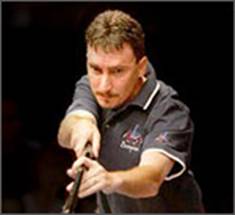
InsidePOOLmag.com
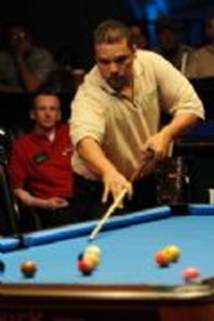
Rodney Morris’ break shot
MatchRoomSport.com
The next series of pictures shows several professionals during match play. Here too the straight wrist with the adductor pollicis muscle pointing at the object ball is nearly invariable among the pros.
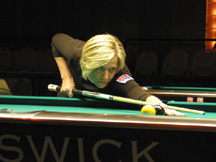
Allison Fisher InsidePOOLmag.com
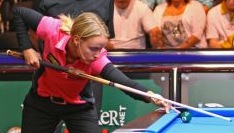
Jasmin Ouschan MatchRoomSport.com
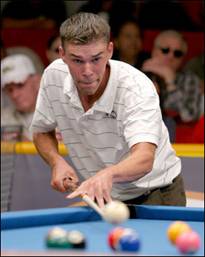
Corey Deuel’s break shot InsidePOOLmag.com
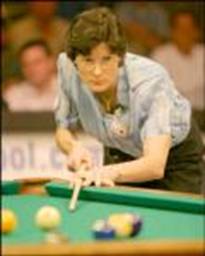
Karen Corr’s break shot InsidePOOLmag.com
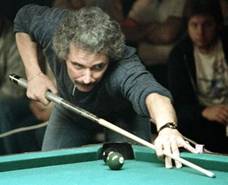
Jimmy Reid InsidePOOLmag.com
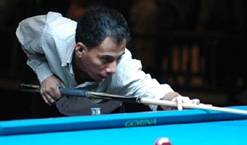
Dennis Orcollo azbilliards.com by Rick Schmidt
Perhaps one of the best photographs of this straight wrist is from days gone by.
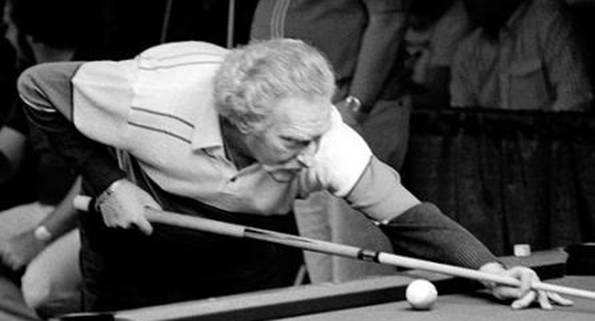
Billy Burge (Cornbread Red) InsidePOOLmag.com by JR Calvert
The straight wrist is not confined to use by Americans. Jasmin Ouschan, Dennis Orcollo shown above and Niels Feijen shown below have also learned that a straight wrist is necessary for consistency in shot making.
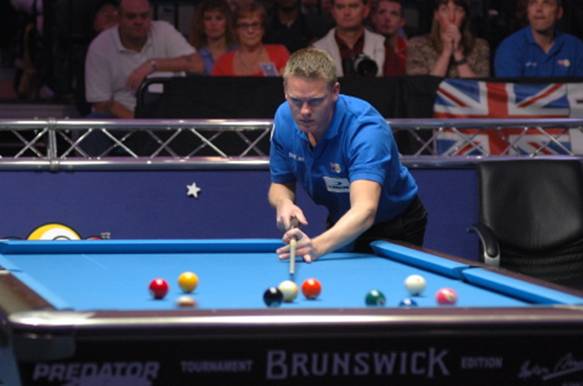
Niels Feijen Break shot azbilliards.com by Rick Schmidt
Finally Corey Deuel has perhaps one of the most pronounced straight wrist finish positions in the game today. He is also one of the top players.
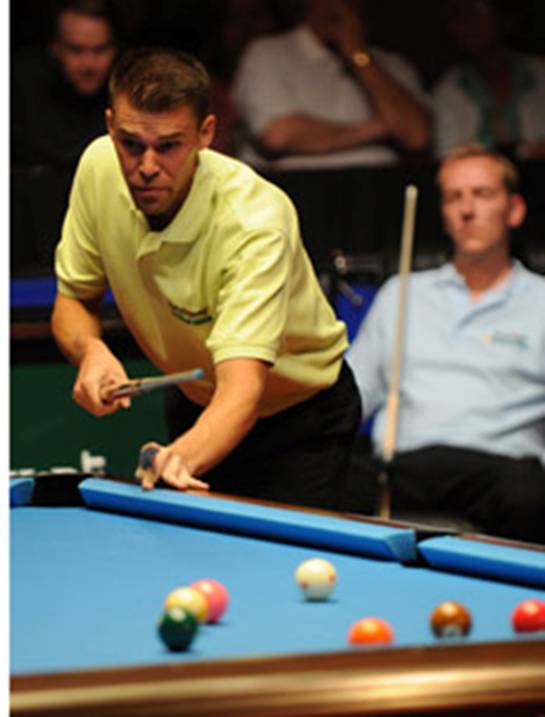
Corey Deuel’s break shot (WorldPoolMasters.com)
So it would appear that if you want to shoot like the pros you will need to learn to keep your wrist straight and the adductor pollicis muscle on the aim line. To obtain this position some people (see Dennis Orcollo above) release their little finger and their ring finger from the cue. Others do not. However you do it you must have that bent wrist in line with the forearm for solid follow through. Jose V on Billiards Digest Cue Chalk Board said that when he shoots a break shot the rear of the cue stick hits his forearm. That is one way to know that the cue stick and your hand are on line.
If your shots are erratic you are probably letting your wrist move from side to side as you hit the ball. The distance from the hinge on your wrist bone to the location of the stick in your hand is four to five inches. A tremor in your wrist will change the angle of hit by at least the margin of error. In addition, a tremor in your wrist when carried from your right-hand to the tip of the cue stick is indeed a substantial amount of movement. No wonder you missed that long shot.
It can be concluded that side wrist movement must avoided. It is for this reason that each of the players in the pictures has that funny bend in their wrist at the end of their strokes. It would also seem that they are aiming the APM.
If you tend to carry your stick from the side, instead of letting it lay dead straight down, you have to compensate for the angle your wrist is off dead straight and you must hold that exact same angle through the stroke. Some people can do this, Earl Strickland for example. All of the other pros let the cue stick hang dead straight.
While you must lock out the side movement of your wrist you must continue to have a flowing forward and backward movement of the wrist to get that smooth even stroke. It takes at least two weeks to master this stroke and learn to aim with the adductor pollicus muscle (APM). It is not as easy as it looks to get this final hand position on every stroke, soft, easy, hard, open or closed bridge, reaching across the table or shooting off the rail. Draw shots and force follow. One of the things that you will find is that your accuracy will improve by leaps and bounds. You will also find that you need less English. Fact is, it will change your whole game. For a while it is ruined, later you will run twice as many balls, assuming the rest of your basic stance is good.
The place where you may continue to have problems and often revert to a “loose” wrist is when draw is needed. It seems that with a locked wrist you cannot swing the stick as fast. This affects the length of the draw: It is shorter. So it looks like there is a trade off. Accuracy is improved but speed of swing is reduced.
When extreme draw is needed a loose wrist is required, you have to be close to the object ball or it isn’t worth trying. In the past there was a 50% probability of making the shot and getting position. That simply isn’t good enough, no matter how fancy it makes you look on the table. Locking out the horizontal (side) swing in your wrist is going to improve your whole game — but you will have to work at it — and with it.
The eyes (through the brain) guide the hand but what part of the hand should they guide? Through out life we learn to point with our index finger. You can, if you choose, point with your little finger and your brain will know how to coordinate your body to align the little finger under the eye to point at the exact spot. There is no need to look at your hand when you point at an object because the brain knows where it is located and makes the calculations that will place the little finger on line. The body / brain is an amazing machine that has exquisite abilities we simply take for granted.
Given that you can point either of your fingers directly at a target it would be a good idea to teach the brain to point a particular part of the hand, APM in this case, to improve one’s control
The pros may do this without labels and without thinking about it. The player attempting to reach that level of skill may be able to enhance the process through an understanding of what takes place.
